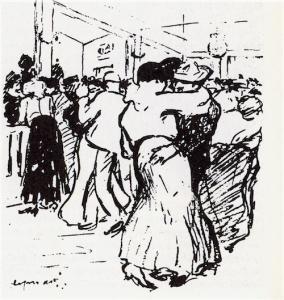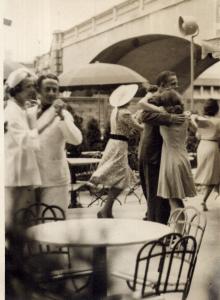- Historical Dance
- Jazz Age Social Dancing ("The Modern Dances")
- 0. The Essentials of Jazz Age Ballroom Dancing
- 1. Foxtrot Part 1: The Jazz Age Foxtrot
- 2. Youth Dancing in the Jazz Age
- 3. The Jazz Age Waltz
- 4. The Jazz Age Tango
- 5. 1930s Rumba
- 6. 1930s Samba
- 7. 1930s Conga
- 8. Bal Musette: Parisian Dance of the Jazz Age
- 9. Dancing in Weimar Berlin
- Dancing Made Easy - 1922
- Film Library - Jazz Age Dance
- Historical Dance Films posted to Pinterest
- Jazz Age Dance - Apologia
- Jazz Age Dance Image Collection
- Jazz Age Lead and Follow
- Places to Dance in Southern California in the Jazz Age
- Sampler of Jazz Age Dance Holds
- The Pathé Historical Dance Collection: 1920s-40s
- Ragtime Dance - the One Step
- Regency Dance
- Victorian Dance
- Jazz Age Social Dancing ("The Modern Dances")
b. La Java (French Waltz Variation)
 The Java was a distinctly French Waltz variation danced to a bouncy 3/4 beat. The distinction between a Java and a Waltz was not a clear bright line. Bouncy moderate tempo Waltzes, which sound a bit like a Victorian Waltz-Mazurka, were definitely "Java", but the film evidence suggests that individual styling and step choices were all over the map, with a lot of dancers doing their own particular favorite style to most any tempo, whether it be a Java type step or something else.
The Java was a distinctly French Waltz variation danced to a bouncy 3/4 beat. The distinction between a Java and a Waltz was not a clear bright line. Bouncy moderate tempo Waltzes, which sound a bit like a Victorian Waltz-Mazurka, were definitely "Java", but the film evidence suggests that individual styling and step choices were all over the map, with a lot of dancers doing their own particular favorite style to most any tempo, whether it be a Java type step or something else.
The main difference between the classic Waltz and the Java is that the Java tempo lent itself to a bouncy step (one walking step per beat, with equal emphasis on each step, a slight bounce in every step and a bit of hip and shoulder action) which in these clips you can see a lot of people dancing - though many seem to be just doing their usual mix of Waltz steps, turns and pivots. You can also see a lot of variation in style, from a sensuous sway to a jerky hop to a smooth flow to a continuous rotation.
 Also, in keeping with the French dance style of the Jazz Age, they kept it really simple. You don't see elaborate step patterns or practiced dance routines. The couples just moved around the floor doing pretty much the same one or two things through the whole dance and they didn't separate until the dance was over. As usual, no underarm turns, throw-outs etc.
Also, in keeping with the French dance style of the Jazz Age, they kept it really simple. You don't see elaborate step patterns or practiced dance routines. The couples just moved around the floor doing pretty much the same one or two things through the whole dance and they didn't separate until the dance was over. As usual, no underarm turns, throw-outs etc.
Below is a compilation of clips from European films of the '20s and '30s, showing the Java being danced in a variety of venues, from a seedy dockside tavern to a posh Parisian cafe. The second scene, which is actually from a German film, where the woman drapes herself over the man and they rock back and forth suggestively, is the classic, perhaps even stereotypical, low life, "apache" (pronounced ah-pash) style (note, one step per measure rather than the usual three). On the other extreme, the scene where Jean Gabin dances with the nice old lady, shows a style where he lifts up on the balls of his feet, rather than dancing flat footed as most do, and this gives the Java a smooth, graceful, civilized flow.
After all this, I suggest doing as the Parisians did: hold your partner close and dance your dance in the style that suits you.
Next: French Tango
